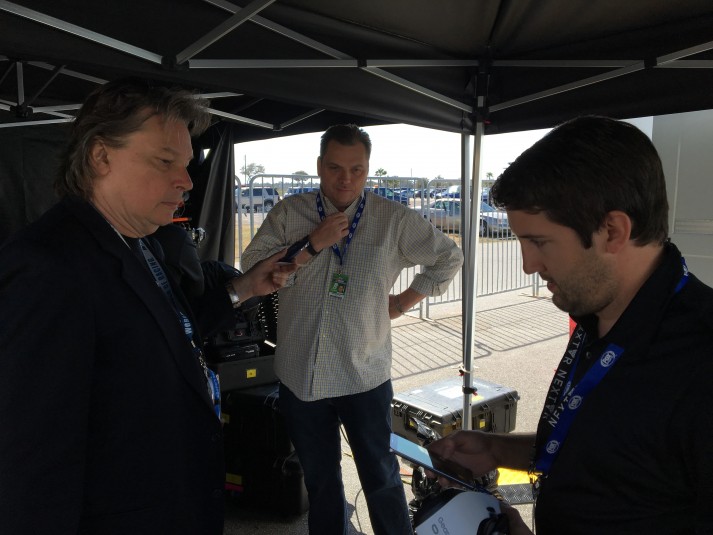Fox Takes VR to Next Level at Daytona
Tech partner NextVR provides virtual-reality image of live action prerecorded content for online viewing
Story Highlights
At the Daytona International Speedway on Sunday, Fox Sports applied its virtual-reality initiative to auto racing. Sponsored by Toyota, NextVR, Fox’s technology partner in the venture, followed the action around the track and the venue live with three of its proprietary 3D cameras, providing a compressed but still vivid 2,560×1,440 image to online viewers watching on an Android device through an Oculus VR headset.

SVG’s Dan Daley (left) gets a primer on VR for NASCAR at the NextVR’s Daytona 500 encampment from NextVR’s Matt Amick (right) as Fox Sports’ Michael Davies looks on. (Photo: Carla Gardner)
What viewers saw was a combination of live and prerecorded content, a produced linear stream that Fox Sports SVP, Field and Technical Operations, Michael Davies said was intended to enable them to “experience this as live as possible, as it happens.”
Discussing the project between qualifying races, Davies noted that Fox had previously tested real-time VR at the 2015 U.S. Open golf tournament in Washington and for a Premier Boxing Champions event at Los Angeles’s Staples Center. The company’s first experience with auto racing was at the Verizon IndyCar Series in Fontana, CA, Auto Club Speedway. The past weekend’s Daytona 500 race was its first NASCAR event and its most ambitious project yet. (Fox Sports and NextVR announced on Feb. 17 that they had inked a five-year partnership agreement.)
According to Matt Amick, postproduction supervisor, NextVR, Sunday’s production was a combination of prerecorded content and a live feed from the three cameras. “Just as you would guide the direction of a broadcast show, we guide the audience for the best view for whatever is going on and then lay in some graphics,” he explained. “We mimic what it’s like to be here, but we’re also enhancing that experience.”
Calling the VR initiative a work in progress, Davies said the network’s production approach is evolving as the technology progresses. “When [virtual reality] becomes a regular part of the viewer experience depends a lot on how the consumer devices develop and how good they wind up becoming,” he said at the NextVR encampment in the broadcast compound just outside Turn 3. “These devices are good but have a long way to go. But we have also come a long way in the last year. Auto racing is one of those things where we can put the viewer in places they never would have been able to go.”
He acknowledged that it will be some time before VR can follow a race from start to finish uninterrupted, but, for now, he added, viewers’ ability to “dip in and out of” the online experience is goal enough. “What were doing now is an experiment. It’s a learning process but one that we’re inviting the viewer to join us in. And we’re learning from what we’re hearing back from them as well as from what we’re doing here.”
